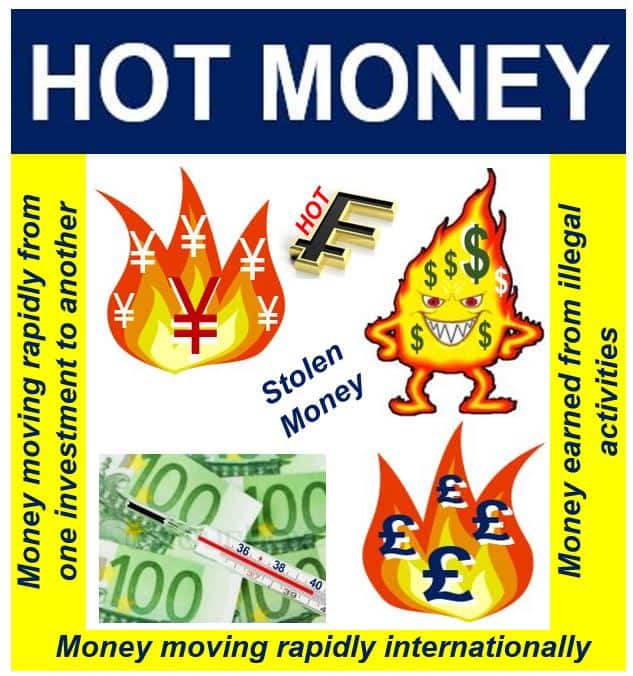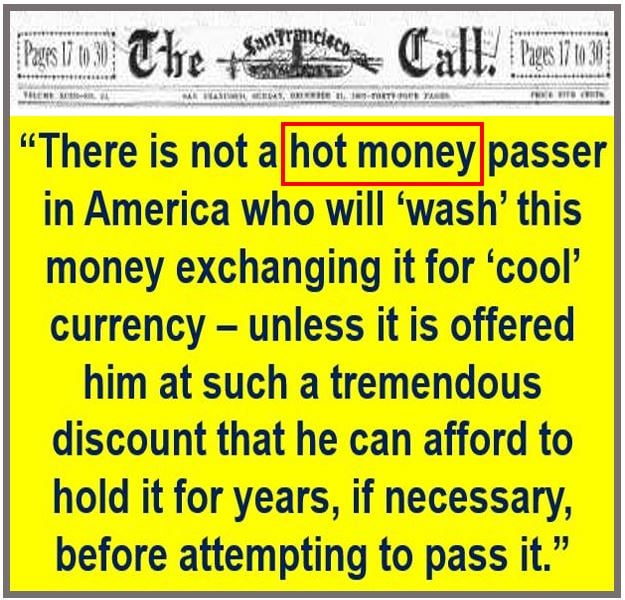Hot money may refer to speculative money – capital that is held in one currency or type of investment but is liable to suddenly and rapidly switch to another currency or investment in search of better profits. With this meaning, the amount of hot money zipping across the globe today is massively greater compared to twenty or thirty years ago.
We also use the term to describe money that can be easily identified if somebody steals it. For example, $100 bills that have consecutive serial numbers or a mark on them.
Most lay people on hearing the term would probably think it meant money that has not yet been laundered. In other words, profits made from illegal activity.

In betting, it is the largest amount of money people have staked on a horse in a race. For example, somebody might say: “The hot money is on Admiral Nelson to win the 2:30.”
If somebody says “But the hot money is on the Fed raising interest rates next month,” it means what experts think will occur. It has the same meaning as “All bets are on the Fed raising interest rates next month.”
It can also mean discretionary income: a portion of somebody’s, a company’s, or any entity’s income that is available for spending on non-essential items or for saving. The total amount of discretionary income in a country is a key indicator of its potential GDP (gross domestic product) growth and is the target of all commercial advertising.

Hot money from country-to-country
In economics, the term often refers to the flow of capital from one economy to another.
Investors and speculators want to earn a short-term profit on interest rate differences or exchange rate shifts.
We use the term for such cases because the money can move extremely rapidly in and out of markets. This can subsequently trigger instability.
In January 2011, the national average rate of a certificate of deposit – one year – in the USA was 0.95%. Contrastingly, China’s benchmark one-year deposit was three percent.
The Chinese renminbi was undervalued against all other major trading currencies. Therefore, it was likely to rise in value against the US dollar in the years to come.
If US investors deposited their money in a bank in China, they would obtain a higher return. Specifically, a higher rate than they would in a bank in the US.
This made China a major target for hot money inflows. This real life example is one of many different possible hot money scenarios.

This ‘hot money’ quote came from The San Francisco Call in 1935. It was a newspaper that served San Francisco in California, that due to a succession of mergers came to be called the San Francisco Bulletin, The San Francisco Call & Post, and the News-Call Bulletin. (Image: adapted from Wikipedia)
Hot money – trail of destruction
Hot money often leaves a trail of destruction in its wake. Imagine Country A experiences a financial crisis. Money flows out of that economy as investors, companies and even individuals people panic. They all seek a more attractive destination for their funds.
The money goes mainly to Country B. In Country B, capital inflows create a boom. Personal and commercial debts increase considerably, asset prices rise, and consumption booms. It only does this for a while.
However, all too often, after these mega capital inflows comes a giant crisis. Country B’s economy deteriorates considerably, mainly because of the hot money that had flowed into it.
Estimating amounts of hot money
It is impossible to estimate accurately how much hot money flows into a country. As this type of money flows rapidly, the authorities monitor it poorly.
A common way of approximating the flow of this type of money is to subtract a country’s trade surplus or deficit and its net flow of FDI (foreign direct investment) from the change in the country’s foreign reserves. ‘Foreign reserves’ refers to foreign currency that the central bank holds.
Approximating Hot Money
Hot Money = Change in foreign exchange reserves – Net Exports – Net FDI
Origin of hot money
Hot money typically originates from the capital-rich, advanced economies. They have smaller economic growth rates and lower interest rates than those of the emerging economies. China, India, Brazil, Russia, and Mexico, for example, are emerging economies.
Some of the reasons for the fast movement of such money across borders are:
- Interest Rates in the advanced economies decline over a long period. The lower interest rates encourage investors to move their funds to emerging economies. Rates are considerably higher in, for examples, Latin American and parts of Asia.
- International Diversification is a general trend among most investors across the world, especially as world capital markets become more integrated.
- Sound Monetary & Fiscal Policies adopted by many emerging economies, as well as capital market liberalization, have made it easier and more appealing for investors to move their money there.
Video – Controlling hot money
Should we control hot money? As this Real News video shows, many economists think we should. If the US were to start imposing controls, the move would be unprecedented.
